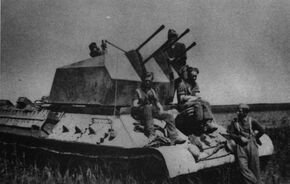
A Flakpanzer IV Möbelwagen operating in France
The development of the famous German ‘Flakpanzer’ series began very early on in the combat history of the Wehrmacht. The first needs for such vehicles came about around the time of the Battle of France in which German military planners came to the conclusion that horse-drawn or tractor driven Flak guns and equipment simply could not keep up with the ever advancing Panzer and motorized infantry forces. Furthermore, once set up, these weapons had little in the way of protection.
However, at that period in time, the need while relevant, was minor in comparison to others. Standard German half-tracks fitted with anti-aircraft weapons also served to answer the need for mobilized Flak, if anything, they performed their function well in the short term. However, the idea of removing the turret of a panzer and replacing it with a Flak gun was not forgotten and the ‘test run’ of this idea was put into practice with the creation of the Flakpanzer I. Although very few examples had been produced, the Flakpanzer I proved its worth on the frontline.
Following it in more reasonable numbers would be the Flakpanzer 38(t) based on the Czech Panzer 38(t). The design of the Flakpanzer 38(t) was meant to give the vehicle a full 360˚ traverse for its weapon, yet at the same time, the protection for the crew suffered. Adding to the problems, the 20mm main armament of the Flakpanzer 38(t) had trouble in critically damaging the more modern Allied aircraft that appeared by the late 1942-1943 time in which it arrived. Another benefit of armored flak units was that the good elevation and traverse ranges allowed them to not only engage aircraft, but attack ‘soft-skinned’ vehicles and directly support ground troops.
Flakpanzer IV[]
The 'true' evolution into the German Flakpanzer came with the Flakpanzer IV series. First was the Möbelwagen, oftentimes called the ‘furniture van’ by its crews for its box-like coverings that protected either the four barreled 20mm Flakvierling 38 gun or 37mm FlaK 43 mounted centrally in the chassis. These coverings could then be released via a latch, exposing the weapon and its crew, but giving it a full fire arc. While the initial version of the Möbelwagen had used the Flakvierling 38 as its main armament, the German high command quickly opted for an ‘interim solution’ vehicle that could once again fill the gaps in German equipment before a more suitable replacement could be found.
Compared to the Flakpanzer 38(t), the Möbelwagen worked well in the field, becoming a useful asset to German ground troops, largely on the Western Front. Next in the Flakpanzer IV series would be the Wirbelwind. The Wirbelwind itself was based on the Möbelwagen’s open-topped Panzer IV chassis but instead had a nine-sided turret armed with a quad Flakvierling 38 mounted on top. The concept of the Wirbelwind itself was submitted by SS-Hauptsturmführer Karl Wilhelm Krause of 12th SS Panzer. Prototyped alongside the Wirbelwind and using the same general design was the Flakpanzer IV Ostwind which instead used a six-sided turret and 37mm FlaK 43 as its main armament. Both vehicles were produced in under 100 production models and were badly needed on the frontlines. They both proved to be quite deadly against low-flying aircraft but simply did not have the numbers to protect German troops.

An example of a Flakpanzer T-34 747(r) operating with Panzerjäger Abteilung 653
The final evolution of the German Flakpanzer ended with the experimental Flakpanzer IV Kugelblitz. With only six prototypes being made, the Kugelblitz was truly a last-ditch attempt at creating the ultimate Flakpanzer. Armament was provided by two formerly aircraft mounted 30mm MK 103 autocannons placed in a low silhouette turret. This was in fact one of the highlights of the Kugelblitz, having a fully enclosed turret and 360˚ traverse meant that it was protected against light infantry attacks and other forms of small arms fire. It is unknown for sure whether the Kugelblitz saw combat, some sources report that the completed Kugelblitz’ operated during the final defense of Berlin. Others report that at least two Kubelblitz’ were knocked out somewhere in East Germany. At any rate, the Kubelblitz was a modern tank which simply did not have the time to make any lasting effect on the battlefield.
Experimenting[]
It should be noted that Germany did have other Flakpanzer projects such as the Flakpanzer V Coelian which were cancelled or field conversions of captured enemy vehicles like the T-34 into Flakpanzers, typically armed with an array of 20mm Flakvierling 38s. All of these examples only serve to show the effects of desperation on ingenuity and requirement on invention.
References[]
- Lepage, Jean-Denis. Spellmount (The History Press). (2012)
- US War Department. Tactical Employment of Flak in the Field. Intelligence Bulletin (1943)
- "Flakpanzer IV Mobelwagen (Sd.Kfz.161/3)." Achtung Panzer, n.d. Web.
- “Flakpanzer IV Wirbelwind and Ostwind.” Achtung Panzer, n.d. Web.

